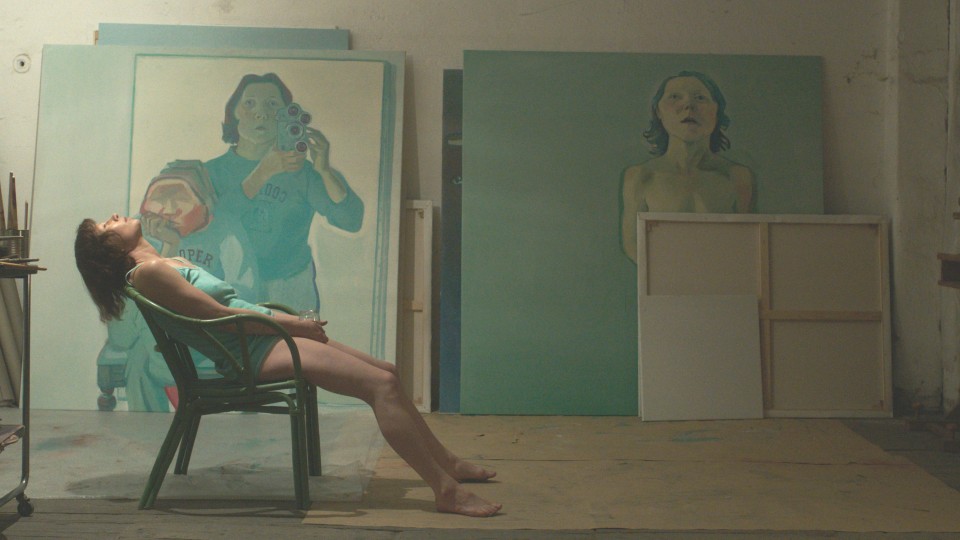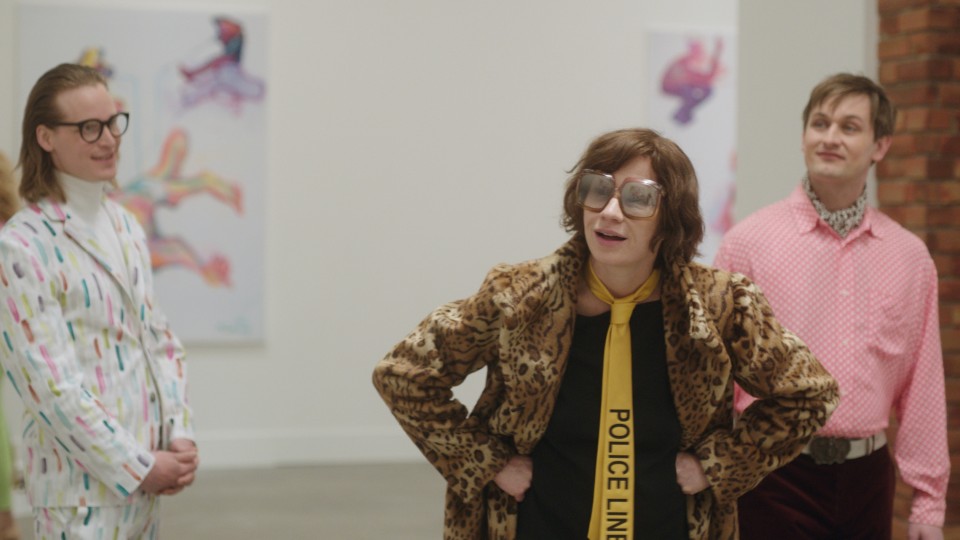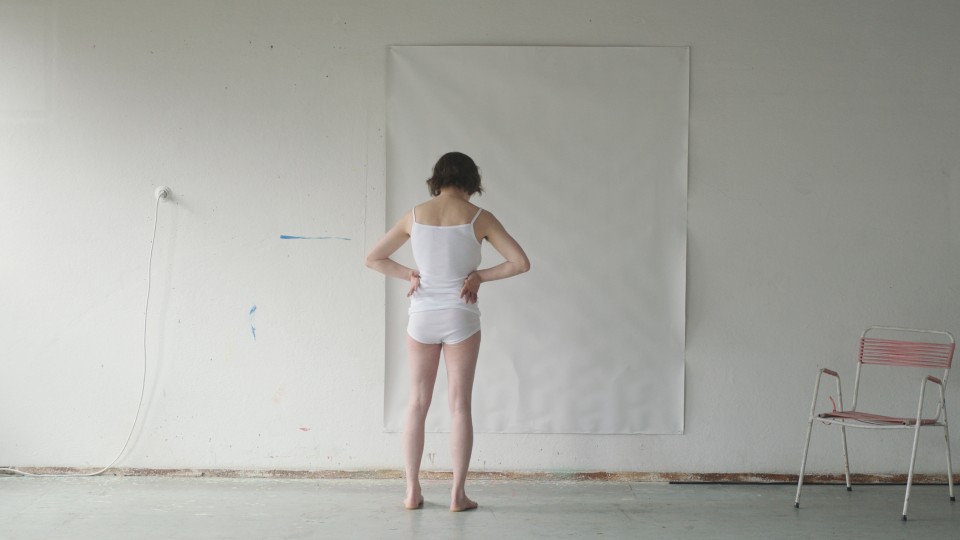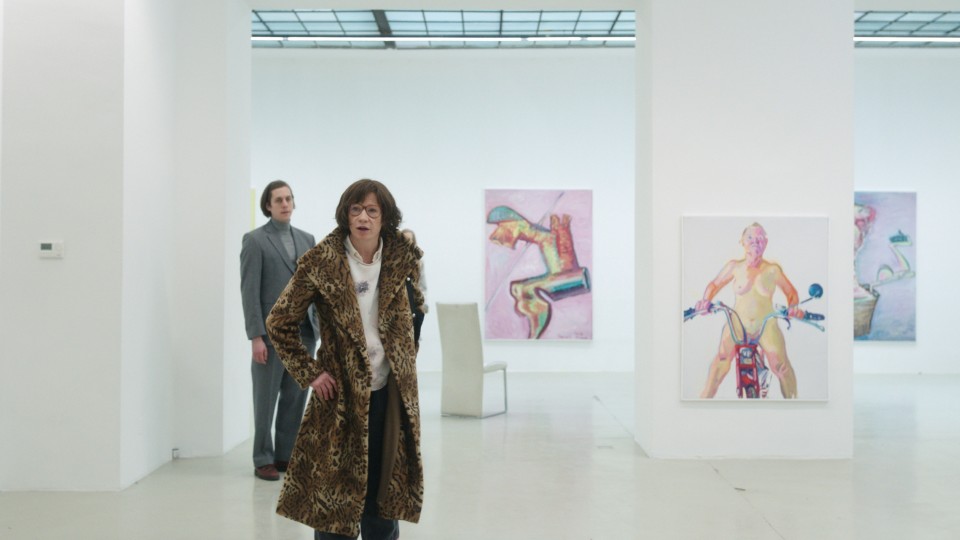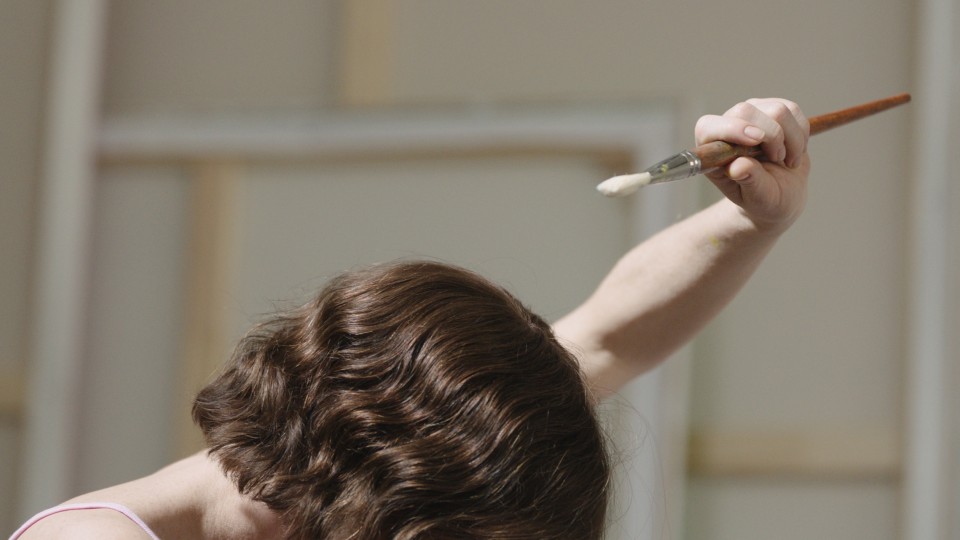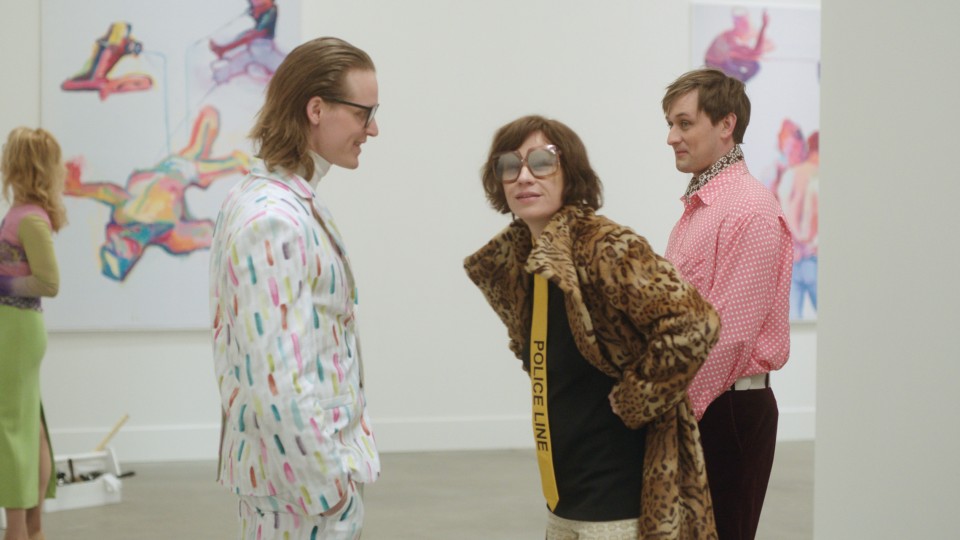Fame, international recognition, high prices on the art market. By the end of her life, 95-year-old Maria Lassnig had achieved
everything she’d so much desired. It had been a long road. Anja Salomonowitz moves along Lassnig's life story to permeate
into her processes of perception and creation, creating in SLEEPING WITH A TIGER a portrait of an artist which engages with the internal and external worlds of this fascinating painter.
What was it about Maria Lassnig's oeuvre that sparked your interest in making a film about her?
ANJA SALOMONOWITZ: The colors. I have seen her paintings in the Essl Collection in Klosterneuburg, and in exhibitions in Vienna or Munich. The
pictures are so inspiring, the strident, expressive colors so intense. At first, I said to myself that colors alone are not
enough as a starting point for a film. It was only later that I realized colors could be a more than suitable starting point
for a film like this.
Lassnig's biographer Natalie Lettner says: The biography of Maria Lassnig is the story of self-empowerment. Was the combination
of life story and colors the foundation, prompting a search for a cinematic form appropriate to something that is more than
a biography?
ANJA SALMONOWITZ: Yes, and after that, of course, the life story came into play. And yes, Lassnig's biography is the story of self-empowerment.
Her life was defined by her struggle for recognition in the male art world. Another formative element is her later success.
Lassnig achieved the fame she had dreamed of, she smashed through the glass ceiling, but she was no longer able to appreciate
it or enjoy the wealth that derived from it. She certainly didn't want to, either. The spartan life corresponded to her ideal
as an artist. Over the decades, she became accustomed to these meagre living conditions. Then, when a lot of exhibitions were
held in her honor, she often behaved terribly badly, which was also a consequence of her inability to believe fully what had
finally happened, at such a late stage. Whenever she managed to gain a foothold, she fled again. That led to the fact that
she lived in Paris, Berlin and New York.
What was the basic impetus for you to engage with a female artist?
ANJA SALOMONOWITZ: I started working on this project back in 2013. First of all, I wanted to question the classic portrait of the artist – which
is to say, a male artist – that operates in exhibitions. Invariably this involves a white, aging, eminent artist, and he gives
an interview to camera. In response, I wanted to reflect on the art market and its mechanisms. I looked at a lot of female
artists, but I kept coming back to Maria Lassnig. At first, I had the idea of working only with a child; the child would play
Lassnig, and only her environment would grow older. At a certain point, though, this concept wouldn’t work anymore. I had
already interviewed lots of people from the art world who told me very funny stories about Maria Lassnig. I then planned to
make a documentary where they all appear, but in the end I stuck with the narrative form.
Instead of using a child, now you have one adult actress embodying all the phases you depict in Maria Lassnig's life, without
make-up to show how old she is. So the basic idea of suspending time has remained.
ANJA SALOMONOWITZ: I wanted time to be suspended, because that conveys the way the soul morphs and meanders through time – and also because
memories and feelings are not anchored in any particular time. By constantly making time jumps, I ensure that everything falls
out of time; the point is an inner state, not its location. For me, this is also the aspect of SLEEPING WITH A TIGER that’s
closest to a feature film. I have tried to create this spherical level, where you enter the subconscious, because that’s the
sphere in which Maria Lassnig found herself so much. You can read her diaries and feel in the pictures how she embarks upon
a stream of consciousness and tries to find meaning in it.
How did you choose Birgit Minichmayr, who portrays the artist in all phases of her life?
ANJA SALOMONOWITZ: There was no choice; it was simply clear. For a symposium at the Vienna Albertina Museum, Birgit Minichmayr was invited to
read excerpts from Lassnig's diary. When I heard her read, I just thought: "She’s the one." The script was already designed
in such a way that one person plays everything. Birgit agreed immediately. At the moment when we were filming, Birgit Minichmayr
was Maria Lassnig for me. Or let's say: our interpretation of Maria Lassnig. She did it perfectly.
You also repeatedly step out of the linear and fact-based narrative with other elements. Are you deliberately defying formal
conventions as a reference to the hybrid character of a biographical narrative?
ANJA SALOMONOWITZ: That was definitely a concern for me. I wanted to reveal that the view of an artist's personality is always an interpretation.
A biography always remains an interpretation. When it came to casting, it was important for me to include people who play
themselves or come from the environment they portray. The curator Diethard Leopold plays a museum director. The photographer
Elfie Semotan plays herself in exactly the scene she told me about during the research interview. However, a lot of the interview
was omitted from the editing because it was too "awake" for the unconscious state the film occupies. The ants that carry home
Lassnig's exhibition portfolio are part of her unconscious world. She was always involved with animals a lot, and in a way
she felt closer to the animal world than the human world.
Were you also interested in getting close to Lassnig's sense of color and body?
ANJA SALOMONOWITZ: I've been told that Lassnig would enter her studio in the mornings, sit down and wait for the feeling to come, which she
later transferred onto the canvas. She felt her way into it. She says, for example, that when she depicts herself with no
hair in many of her paintings, it’s because she doesn’t feel her hair at the moment she’s painting. Her cheek might be red
because it was hot. She gave names to the colors. There are colors of decay, colors of death, colors of jealousy. When she
sits on an armchair, she endeavors to find out where the armchair begins and the skin ends. What is in that little space between
the skin and the armchair? Does the chair eat into the body or do the buttocks extend downwards? What matters to her are minimal
perceptions. She’d spend hours waiting for that to come – and then paint relatively quickly. The picture itself would be finished
in a few hours. Maria Lassnig painted an incredible number of pictures.
In view of her wide-ranging body of work, how did you choose the pictures for the film?
ANJA SALOMONOWITZ: We worked together with the Maria Lassnig Foundation, which granted us the rights to use the images. Of course, we couldn't
film the real pictures. I made the selection according to two criteria: I wanted to find concise images that were representative
of her work, but at the same time, I let myself be guided by the colors on a purely visual level. In New York, her works featured
a lot of turquoise, so we bathed the whole New York section in turquoise. In terms of production design, the concept was for
everything to be basically white – dingy white, as her studios often were, or high-gloss white, like a gallery space or an
exhibition catalogue. Through the pictures or the furnishings, the colors come back into the film image – a blue telephone,
a pink armchair. The costume designer Tanja Hausner and set designers Martin Reiter and Andreas Ertl worked extremely well
together.
Why did you choose Sleeping with a Tiger as the titular image?
ANJA SALOMONOWITZ: Because I perceive the meaning as something like "wrestling with the world". For me, Sleeping with a Tiger represents what she did: torturing herself, struggling, in other words: wrestling with the world. But there was also the
interpretation that she herself is the tiger. I like that interpretation very much, too. For me, the title is like an inner
image of her emotional world.
She may have struggled, but she also lived for art through and through, and in that sense she realized her full potential.
Was there never a feeling of satisfaction with herself?
ANJA SALOMONOWITZ: It wasn’t just that she felt she couldn't have children because then she wouldn't be able to get into art anymore. She also
felt that men would prevent her from making art. As a young woman, she was idolized and had lots of affairs. But she was disappointed
again and again, and at some point she decided to remain alone.
There was a sense of satisfaction. Every time she finished painting a picture, she said, she felt satisfied, because at that
moment the feeling was in the picture and out of her.
Lassnig wanted to be compared with her great male contemporaries. With Munch, Van Gogh and Velázquez, she saw herself in a
line of fine artists. She also always wanted to be known as a painter, using the male form of the word in German. She didn't
want to be appreciated because of her womanhood, but because of her art. At the same time, by succeeding to the extent that
she did, she played a great pioneering role and had an emancipating effect on many woman artists who came after her. Unintentionally
feminist, so to speak. She managed to become the most expensive Austrian woman artist.
What did it mean for the editing process, dealing with the suspension of time?
ANJA SALOMONOWITZ: Joana Scrinzi and I spent over a year editing the film, with long breaks. The script provided a sequence, but we didn’t have
to adhere to that in the editing. We then searched for a long time for a form that would allow us to sink into Lassnig's sphere
of consciousness and handle the issue of old age. We actually ended up back with a more or less chronological form. I think
Maria Lassnig would find the film funny, the way it’s made. I think she'd like the fact that it was made so differently.
Why was it so important to you to stay in this unconscious sphere of the artist?
ANJA SALOMONOWITZ: Because I think that's where creativity is. Because that’s where Lassnig was. She put herself in that state every day. Mercilessly.
She showed no mercy to herself. I believe that Lassnig's desire for art, for making art, was about overcoming mortality. About
achieving a form of immortality by disposing of herself through her works. With hindsight, my film actually deals throughout
with death and overcoming death. The experience of mortality, the desire for immortality and the awareness that all times
are simultaneous and can also shift; all that is constantly present.
Interview: Karin Schiefer
January 2024
Translation: Charles Osborne

